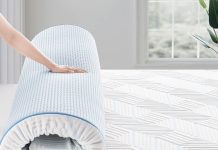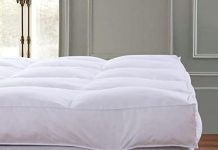Taking care of your mattress is essential for a good night’s sleep, but do you know how often you should be rotating or flipping it? In this article, we will uncover the secrets behind maintaining your mattress’s longevity and ensuring optimum comfort. Whether you’ve just invested in a new mattress or have been sleeping on the same one for years, it’s time to discover the perfect mattress maintenance routine. Get ready to learn the tricks of the trade and say goodbye to restless nights!
Review contents
Importance of Rotating and Flipping Mattresses
Enhances Mattress Lifespan
Rotating and flipping mattresses is an essential practice that can significantly enhance the lifespan of your mattress. Over time, mattresses can develop uneven wear due to the constant pressure exerted on specific areas. By regularly rotating and flipping your mattress, you distribute the weight more evenly, preventing excessive wear on particular spots. This not only helps to maintain the shape and support of the mattress but also extends its overall lifespan.
Maintains Mattress Comfort
Another significant benefit of rotating and flipping your mattress is that it helps to maintain its comfort level. As we use our mattresses, they conform to our bodies’ contours and develop body impressions. These impressions can make the mattress feel uneven and less comfortable to sleep on. By rotating and flipping the mattress, you can minimize the development of body impressions, ensuring that you have a comfortable and supportive sleep surface for a longer period.
Prevents Body Impressions
Body impressions occur when specific areas of the mattress are continuously subjected to our body weight over time. These impressions can result in uneven firmness and discomfort. By regularly rotating and flipping your mattress, you can prevent the formation of deep body impressions and maintain a more even sleeping surface. This can lead to improved overall comfort and a more restful sleep experience.
Prevents Uneven Wear
In addition to maintaining the comfort of your mattress, rotating and flipping it can also prevent uneven wear. When we sleep, we tend to have our preferred sleeping positions and spend more time on certain parts of the mattress. This can cause uneven use and wear on those areas, leading to prematurely worn-out spots. By rotating and flipping the mattress regularly, you ensure that all areas of the mattress receive equal pressure and wear, preventing the development of uneven spots.
Factors Influencing Rotation and Flipping Frequency
Mattress Type
The type of mattress you have plays a significant role in determining how often you should rotate and flip it. Different mattress materials and constructions have varying levels of durability and resilience. For example, traditional innerspring mattresses are generally more durable and can withstand frequent rotations and flips. On the other hand, memory foam mattresses may not require as frequent rotations and flips due to their unique body-contouring properties.
Mattress Quality
The overall quality of your mattress can also influence the frequency of rotation and flipping. Higher-quality mattresses are typically designed to be more durable and long-lasting. They are often constructed with materials that resist sagging and body impressions. As a result, high-quality mattresses may not require as frequent rotations and flips compared to lower-quality ones.
Body Weight
Individuals with a higher body weight tend to exert more pressure on their mattress, resulting in greater wear and compression. If you and your partner have a higher combined body weight, it is advisable to rotate and flip your mattress more frequently. This will help distribute the weight more evenly and prevent excessive wear on specific areas.
Sleeping Habits
Your sleeping habits can also affect how often you should rotate and flip your mattress. For example, if you tend to sleep in the same position throughout the night, you may need to rotate and flip your mattress more frequently to prevent the development of body impressions. Conversely, if you often change sleeping positions, your body weight is distributed more evenly, and you may not need to rotate and flip as often.
Rotating Frequency for Different Types of Mattresses
Innerspring Mattress
Innerspring mattresses, known for their use of steel coils, are generally more resilient and durable. These mattresses can be rotated and flipped every 3-6 months to ensure even wear and maintain their longevity. Rotating the mattress involves turning it 180 degrees so that the foot end becomes the head end. Flipping the mattress involves turning it over so that the top side becomes the bottom side.
Memory Foam Mattress
Memory foam mattresses, renowned for their ability to contour to your body shape, may not require as frequent rotations and flips. Due to their unique construction, memory foam mattresses conform to your body’s contours and return to their original shape when not in use. Rotating these mattresses every 6-12 months should be sufficient to prevent excessive wear and maintain their comfort and support.
Latex Mattress
Latex mattresses are known for their durability and resilience. These mattresses can be rotated every 6 months to ensure even wear and prolong their lifespan. However, flipping is not necessary as latex mattresses typically have a single sleep surface that cannot be turned over.
Hybrid Mattress
Hybrid mattresses combine the benefits of innerspring and foam or latex layers. The specific rotation and flipping frequency for hybrid mattresses can vary depending on the materials used. As a general guideline, rotating these mattresses every 6 months and flipping them once a year should be adequate to maintain their integrity and comfort.
Flipping Frequency for Different Types of Mattresses
Double-Sided Mattress
Double-sided mattresses are designed to be flipped regularly to even out wear and prolong their lifespan. These mattresses have the same construction and comfort layers on both sides, allowing you to enjoy a fresh sleep surface by simply flipping the mattress. Flipping a double-sided mattress every 6 months is recommended to maintain its support and prevent sagging or body impressions.
Single-Sided Mattress
Single-sided mattresses, also known as “no-flip” or “one-sided” mattresses, are designed to be used on one side only. These mattresses typically feature a non-slip bottom surface that prevents the need for flipping. While you won’t need to flip a single-sided mattress, it is still advisable to rotate it every 3-6 months to ensure even wear and maintain its comfort and support.
Signs Indicating the Need for Mattress Rotation or Flipping
Sagging or Indentations
If you notice significant sagging or body impressions on your mattress, it is a clear sign that it needs to be rotated or flipped. These impressions can result from uneven wear or continuous pressure in specific areas. By rotating or flipping the mattress, you redistribute the weight and prevent further deepening of the sagging or indentations.
Uneven Firmness
If you find that your mattress feels uneven or lumpy in certain areas, it may be a sign that it needs to be rotated or flipped. Uneven firmness can occur when specific areas of the mattress are subjected to more pressure and compression than others. Regularly rotating and flipping the mattress can help alleviate this issue and ensure a more consistent level of comfort throughout the surface.
Discomfort or Pain
Experiencing discomfort or pain when sleeping on your mattress is another indicator that it may need to be rotated or flipped. Over time, mattresses can lose their supportive properties, leading to misalignment of the spine and pressure points. By rotating or flipping the mattress, you can restore its support and potentially alleviate any discomfort or pain you may be experiencing.
Allergies or Respiratory Problems
If you or your partner suffer from allergies or respiratory problems, such as asthma or dust mite allergies, regular mattress rotation and flipping are essential. Dust mites and other allergens can accumulate on the surface of the mattress, causing potential health issues. By rotating and flipping the mattress, you expose different areas to fresh air and sunlight, reducing the chances of allergen buildup and improving indoor air quality.
Proper Techniques for Rotating and Flipping a Mattress
Seek Help if Needed
Rotating and flipping a mattress can be a physically demanding task, especially for larger or heavier mattresses. If you are unable to handle the mattress on your own, it is advisable to seek assistance from a friend or family member.
Clear the Surrounding Area
Before attempting to rotate or flip the mattress, ensure that the surrounding area is clear of any obstacles. Move furniture and other items as necessary to provide enough space for the mattress to be maneuvered.
Remove Bedding and Accessories
Strip the mattress of all bedding, including sheets, pillowcases, and mattress protectors. Remove any accessories, such as pillows or stuffed animals, that may impede the rotation or flipping process.
Protective Mattress Covers
Consider using a protective mattress cover or pad to shield the mattress from spills, dirt, and dust. These covers can help extend the lifespan of your mattress and make cleaning easier.
Use Proper Lifting Techniques
When lifting the mattress, use proper lifting techniques to avoid strain or injury. Bend at your knees, not your waist, and lift with your legs, keeping your back straight. Avoid twisting or jerking motions while carrying the mattress.
Rotate Clockwise or 180 Degrees
To rotate the mattress, either turn it 180 degrees or rotate it clockwise. This will ensure that different areas of the mattress are exposed to varying levels of pressure and use.
Flip the Mattress Completely
If you have a double-sided mattress or a mattress that allows flipping, carefully lift and flip it so that the top side becomes the bottom side. Double-check that the mattress is properly aligned and centered on the bed frame after flipping.
Replace Bedding and Accessories
Once the mattress has been rotated or flipped, replace all bedding and accessories. Ensure that the fitted sheet fits snugly over the newly rotated mattress to prevent it from slipping or shifting during sleep.
Frequency Recommendations for Rotating and Flipping
Every 3-6 Months for Innerspring Mattresses
For innerspring mattresses, rotating should be done every 3-6 months, while flipping is optional. This frequency helps ensure even wear and prevents the formation of body impressions.
Every 6-12 Months for Memory Foam Mattresses
Memory foam mattresses typically do not require as frequent rotations and flips due to their unique properties. Rotating every 6-12 months is generally sufficient to maintain their comfort and prevent uneven wear.
Once or Twice a Year for Latex Mattresses
Latex mattresses are known for their durability, and rotating once or twice a year should be enough to distribute wear evenly. Flipping is not necessary for latex mattresses, as they usually have a single sleep surface.
Every 6 Months for Hybrid Mattresses
Hybrid mattresses, combining innerspring and foam or latex layers, should be rotated every 6 months to ensure even wear. Flipping once a year can further prolong their lifespan and maintain their comfort.
Every 6 Months for Double-Sided Mattresses
Double-sided mattresses should be flipped every 6 months and rotated during the flipping process. This frequent rotation and flipping help prevent sagging and body impressions, maximizing the mattress’s lifespan.
No Need to Flip Single-Sided Mattresses
Single-sided mattresses do not need to be flipped due to their one-sided design. However, rotating every 3-6 months is recommended to promote even wear and maintain comfort.
Exceptions and Special Considerations
Manufacturer Recommendations
It is essential to consider the manufacturer’s recommendations for rotating and flipping your mattress. Some mattresses may have specific guidelines that differ from the general recommendations. Consult the manufacturer’s instructions or contact their customer service for any specific instructions.
Individual Comfort Preferences
While rotating and flipping your mattress helps maintain its integrity and prolong its lifespan, individual comfort preferences should also be considered. If you find that rotating or flipping your mattress affects your comfort negatively, you may need to adjust the frequency according to your personal preference.
Health Conditions or Injuries
If you have specific health conditions or injuries that require particular mattress support, consult with your healthcare provider before rotating or flipping your mattress. They can provide guidance on any modifications or accommodations needed to ensure your comfort and well-being.
Mattress Toppers and Pads
If you have a mattress topper or pad on your mattress, consider removing and rotating or flipping them as well for more even wear and maintenance. Follow the manufacturer’s recommendations for caring for these additional bedding layers.
Conclusion
Rotating and flipping your mattress is an essential practice that can greatly enhance its lifespan, maintain comfort, prevent body impressions, and prevent uneven wear. The frequency of rotation and flipping depends on various factors such as mattress type, quality, body weight, and sleeping habits. By following proper techniques and frequency recommendations, you can ensure that your mattress stays in optimal condition and provides you with a comfortable and supportive sleep surface for years to come. Remember to consult manufacturer guidelines, consider individual comfort preferences, and seek professional advice when necessary. With proper care and attention, your mattress will continue to provide you with a restful and rejuvenating sleep experience.
























